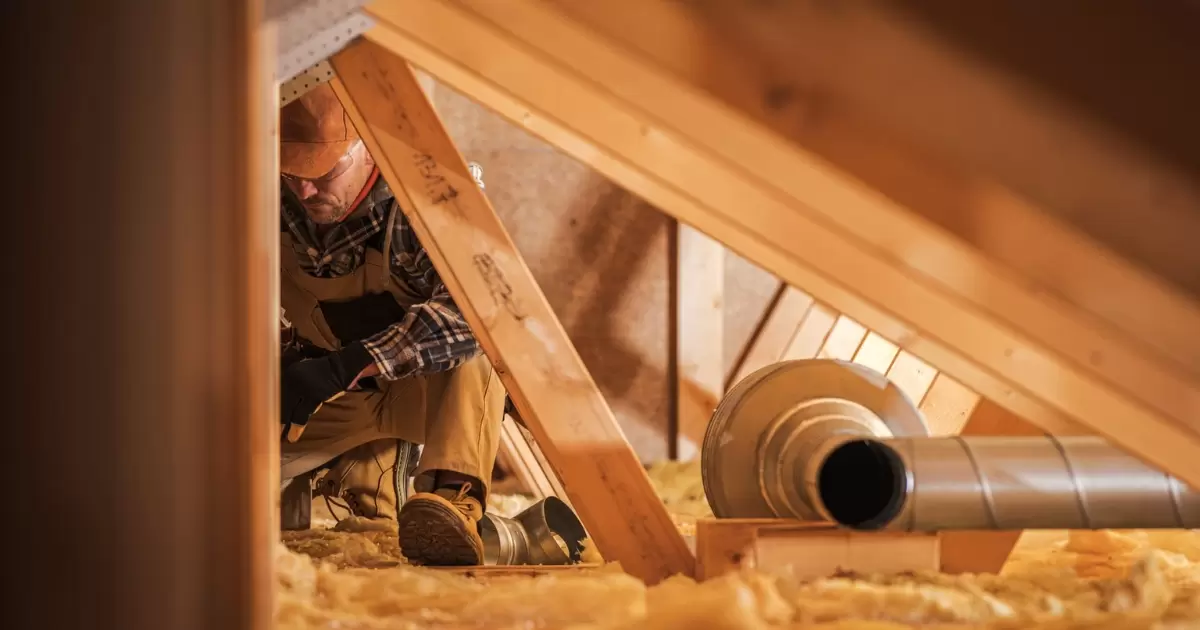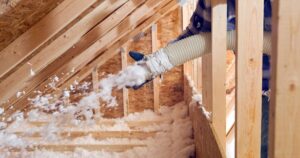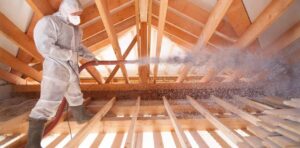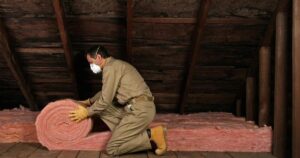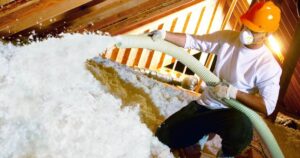The appropriate depth of insulation in an attic largely depends on various factors, including the climatic zone, the type of insulation used, and local building codes. A general guideline often recommended by the U.S. Department of Energy suggests that most attics should have insulation with a depth ranging between 10 to 14 inches, which typically equates to an R-value of R-30 to R-49, depending on the insulation material.
it’s essential to consult local building codes and consider the specific recommendations for your region and the type of insulation being used to ensure the attic’s insulation depth meets the necessary standards for energy efficiency and climate appropriateness.
Importance of Attic Insulation
An often overlooked but crucial aspect of a home’s energy efficiency, attic insulation plays a pivotal role in maintaining comfortable indoor temperatures and reducing energy costs. Properly insulated attics act as a barrier, preventing heat loss in winters and heat gain in summers.
This significantly reduces the workload on heating and cooling systems, leading to lower energy consumption. Adequate insulation contributes to a more sustainable environment by decreasing the overall carbon footprint associated with excessive energy usage.
Effective attic insulation not only ensures a more comfortable living environment but also extends the lifespan of HVAC systems by reducing their constant strain. This, in turn, leads to fewer repairs and replacements, thereby saving money in the long run.
The financial benefits of reduced energy bills coupled with the environmental advantages make investing in proper attic insulation a smart and eco-conscious choice for homeowners.
Energy Efficiency and Cost Savings
Attic insulation directly impacts a home’s energy efficiency by stabilizing indoor temperatures and decreasing the reliance on heating and cooling systems. This results in substantial cost savings in energy bills throughout the year. Properly installed and adequately deep insulation helps maintain a consistent indoor climate, reducing the need for excessive heating or cooling, thereby cutting down utility expenses.
Improved energy efficiency through attic insulation is an investment that yields long-term financial benefits. While the initial installation might incur costs, the return on investment is significant, considering the prolonged savings on energy bills.
It also adds value to the property, making it an attractive asset for potential buyers who are increasingly conscious of energy-efficient features when purchasing a home.
Determining Optimal Insulation Depth
The optimal insulation depth for an attic depends on various factors, including regional climate considerations, R-value requirements, and the type of insulation chosen. Climate plays a crucial role in determining the appropriate depth, with colder climates often necessitating thicker insulation to maintain thermal resistance.
R-value requirements, a measure of insulation’s ability to resist heat flow, further influence the necessary depth for adequate performance. The type of insulation used, whether it’s fiberglass, cellulose, foam, or others, impacts the recommended depth.
Each material has different thermal resistance capacities, influencing the necessary depth for effective insulation. Understanding these interrelated factors is essential in determining the optimal depth to ensure maximum energy efficiency and comfort within the living space.
Climate Considerations
When deciding on the depth of attic insulation, climate considerations are paramount. Colder regions require higher R-values, meaning thicker insulation, to effectively retain heat during winter and prevent heat influx in summer.
In warmer climates, insulation depth may vary to ensure that the interior remains cool, reducing the load on air conditioning systems. Understanding local climate patterns aids in selecting the most suitable depth for optimal thermal resistance.
R-Value Requirements
The R-value of insulation indicates its effectiveness in resisting heat flow. Specific R-value requirements vary based on geographical location and building codes. For instance, colder regions typically require higher R-values.
Understanding these requirements is vital when determining the depth of insulation to meet or exceed these standards, ensuring the attic is adequately insulated for energy efficiency and climate appropriateness.
Type of Insulation
Different types of insulation possess distinct R-values per inch. Fiberglass, cellulose, foam, and other materials offer varying thermal resistance capacities. Considering the pros and cons of each type and understanding their R-value per inch is crucial when determining the depth required for effective insulation.
Factors such as material flammability, installation method, and cost-effectiveness also influence the choice of insulation type and subsequently impact the necessary depth.
Factors Influencing Insulation Depth
Several factors impact the decision regarding insulation depth, including the existing insulation, the attic space and construction, and adherence to building codes and regulations. Understanding and assessing these elements are crucial for making informed decisions about the depth required for optimal attic insulation.
Existing Insulation
Before adding more insulation, evaluating the current insulation’s condition and depth is essential. Upgrading existing insulation or removing and replacing it might be necessary to achieve the desired R-value and energy efficiency. Understanding the existing state helps in determining the additional depth required for effective insulation.
Attic Space and Construction
The attic’s layout, available space, and construction materials impact the practicality of achieving the desired insulation depth. Factors like access to different attic areas, the presence of obstructions, and the configuration of the space influence decisions on insulation depth. Adapting to these limitations is crucial in achieving efficient and uniform insulation coverage.
Building Codes and Regulations
Compliance with local building codes and regulations is fundamental. These standards often stipulate minimum insulation requirements based on climate zones and construction specifics. Adhering to these guidelines ensures not only energy efficiency but also legal compliance and safety in the property.
Calculating the Required Insulation Depth
Determining the necessary insulation depth involves considering guidelines, and measurement techniques, and utilizing available online tools and resources.
Insulation Guidelines
Various guidelines and recommendations are available from government agencies, industry organizations, and manufacturers. These provide insights into the recommended insulation depths based on different factors such as climate, R-value requirements, and insulation types. Following these guidelines helps in determining the optimal depth for efficient insulation.
Measurement Techniques
Accurate measurement of existing insulation and the depth required is crucial. Techniques such as using rulers, probes, or infrared thermography assist in assessing the current depth and identifying areas needing additional insulation. Precision in measurement ensures that the chosen depth meets the required standards.
Online Tools and Resources
Numerous online tools and resources aid in calculating the appropriate insulation depth. Websites, calculators, and software are available to input relevant information such as the type of insulation, current R-value, and geographic location to determine the ideal depth required. These tools provide valuable assistance in decision-making regarding attic insulation depth.
Installation and Maintenance
The process of installing insulation, the choice between DIY and professional installation, as well as maintenance considerations, are pivotal for efficient attic insulation.
DIY vs. Professional Installation
Deciding whether to install insulation personally or hire professionals depends on various factors such as expertise, time, and access to proper tools. DIY installation can be cost-effective, but professional installers bring experience and ensure proper installation that meets all standards and requirements.
Maintenance Tips
Maintaining attic insulation is essential for long-term efficiency. Regular checks for damage, proper ventilation, and ensuring insulation remains evenly distributed are vital for sustained performance. Timely repairs and maintenance prevent energy losses and maintain the desired insulation depth.
Ensuring Proper Ventilation
Attic ventilation is critical in preserving insulation effectiveness and preventing issues such as moisture buildup. Properly installed vents maintain temperature and humidity levels, ensuring the insulation remains efficient. Adequate ventilation prolongs the life of the insulation and prevents structural damage due to moisture.
FAQ’s
What is the required amount of insulation in an attic?
As a general rule of thumb, you need to reach an insulation R-value of R-38 and add between 10 and 14 inches of insulation.
Is 6 inches of attic insulation enough?
The higher the R-value, the better the thermal performance of the insulation. The recommended level for most attics is to insulate to R-38 or about 10 to 14 inches, depending on the insulation type.
Conclusion
Attic insulation is a key factor in maintaining energy efficiency, reducing costs, and ensuring a comfortable indoor environment. Determining the optimal depth requires careful consideration of various factors like climate, R-value requirements, insulation types, and adherence to building codes.
Proper installation and regular maintenance are essential for long-term effectiveness, making attic insulation a worthwhile investment for homeowners looking to enhance both their comfort and savings.

